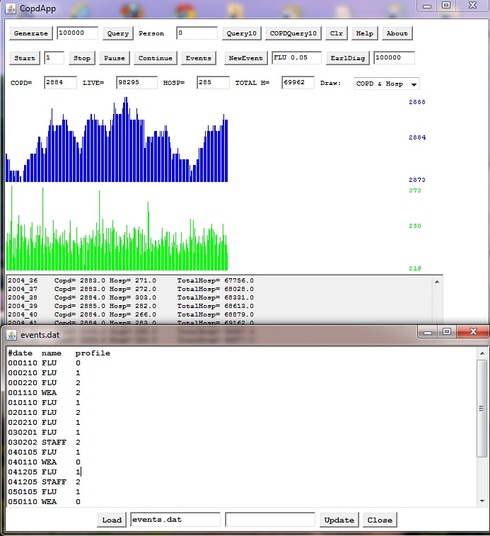COPD Simulator

Agent Based Simulations for Chronic Obstructive Pulmonary Disease (COPD)
Agent Based Simulation for managing COPD in a self-contained NHS region in the UK. Our primary objectives are to:
Agent Based Simulations are a relatively new computing approach. They are suitable for real life problems where there is a medium to large number of interacting agents. Often the development of an Agent Based Simulation itself is useful and educational, and the end product is not something that tells us about the future but is more like a virtual lab to experiment with ideas, and to test possible real life scenarios in a safe environment. Where available, simulations can use properties of real agents, otherwise statistical distributions of real agents are used to generate virtual agents. When real agents are used, simulations of the past can be used to validate the system, and then the system can be used to speculate about the future.
The COPD simulator models a number of agents in a NHS region with a population of around 100,000 people. These people are modelled using statistical distributions and samples available for the region. Each agent has properties such as Name, Gender, Occupation, Education, Smoking Habits, COPD state, Diagnosis, Severity Level, Co-morbidities, Willingness to come to appointments, and Willingness to take medicine. In addition to these, the model contains a number of Primary Health Clinics, Emergency Services, Pulmonary Rehabilitation Units and health care workers. Health related agents can start Anti-Smoking campaigns, Flu immunisation schemes, COPD Rehabilitation Centres and Early Diagnosis initiatives including the use of Spirometry, all entailing costs and benefits to the NHS.
We plan that the simulation period is 30 years starting from 2000 going into 2030. The simulation runs in weekly simulation steps, and at every step it generates the total number of patients, their COPD stage of severity, quality of service they receive and total cost to the NHS. The simulator enables the running of what-if scenarios in terms of investment decisions as well as taking a number of programmed possible actions against the disease.
We planned a number of some random, and some user-defined events such as:
The simulation is developed as a Java applet, and can be placed on a website to be accessed by all the parties involved in COPD. Users can access and run the simulator, and test out their ideas about COPD care. We plan to apply the technology to other chronic disease management tasks in healthcare.
Agent Based Simulation for managing COPD in a self-contained NHS region in the UK. Our primary objectives are to:
- improve understanding of actors (agents) involved in COPD management in the UK
- visualise and create a virtual environment for discussion
- run what-if scenarios
- generate insights in managing and fighting the disease
Agent Based Simulations are a relatively new computing approach. They are suitable for real life problems where there is a medium to large number of interacting agents. Often the development of an Agent Based Simulation itself is useful and educational, and the end product is not something that tells us about the future but is more like a virtual lab to experiment with ideas, and to test possible real life scenarios in a safe environment. Where available, simulations can use properties of real agents, otherwise statistical distributions of real agents are used to generate virtual agents. When real agents are used, simulations of the past can be used to validate the system, and then the system can be used to speculate about the future.
The COPD simulator models a number of agents in a NHS region with a population of around 100,000 people. These people are modelled using statistical distributions and samples available for the region. Each agent has properties such as Name, Gender, Occupation, Education, Smoking Habits, COPD state, Diagnosis, Severity Level, Co-morbidities, Willingness to come to appointments, and Willingness to take medicine. In addition to these, the model contains a number of Primary Health Clinics, Emergency Services, Pulmonary Rehabilitation Units and health care workers. Health related agents can start Anti-Smoking campaigns, Flu immunisation schemes, COPD Rehabilitation Centres and Early Diagnosis initiatives including the use of Spirometry, all entailing costs and benefits to the NHS.
We plan that the simulation period is 30 years starting from 2000 going into 2030. The simulation runs in weekly simulation steps, and at every step it generates the total number of patients, their COPD stage of severity, quality of service they receive and total cost to the NHS. The simulator enables the running of what-if scenarios in terms of investment decisions as well as taking a number of programmed possible actions against the disease.
We planned a number of some random, and some user-defined events such as:
- Weather events (dry/humid and cold spells) increasing workload for Emergency Services and Primary Health
- Flu Events (Light, medium or intense epidemics), similar to above
- A number of NHS related events such as Staff training, restructuring, increased use of Spirometry resulting in costs and potential benefits.
The simulation is developed as a Java applet, and can be placed on a website to be accessed by all the parties involved in COPD. Users can access and run the simulator, and test out their ideas about COPD care. We plan to apply the technology to other chronic disease management tasks in healthcare.